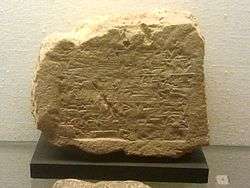Esagila
Coordinates: 32°32′2″N 44°25′17″E / 32.53389°N 44.42139°E

The Ésagila (Sumerian: 𒂍𒊕𒅍𒆷 É-SAǦ-ÍL.LA, "temple whose top is lofty")[1] was a temple dedicated to Marduk, the protector god of Babylon. It lay south of the ziggurat Etemenanki.
In this temple was the cult image inhabited by Marduk, surrounded by cult images of the cities that had fallen under the hegemony of the Babylonian Empire from the 18th century BC; there was also a little lake which was named Abzu by the Babylonian priests. This Abzu was a representation of Marduk's father, Enki, who was god of the waters and lived in the Abzu that was the source of all the fresh waters.
The Esagila complex, completed in its final form by Nebuchadnezzar II (604–562 BC) encasing earlier cores, was the center of Babylon. It comprised a large court (ca. 40×70 meters), containing a smaller court (ca. 25×40 meters), and finally the central shrine, consisting of an anteroom and the inner sanctum which contained the statues of Marduk and his consort Sarpanit.
According to Herodotus, Xerxes had a statue removed from the Esagila when he flooded Babylon in 482 BC, desecrated the Esagila and sacked the city. Alexander the Great ordered restorations, and the temple continued to be maintained throughout the 2nd century BC, as one of the last strongholds of Babylonian culture, such as literacy in the cuneiform script, but as Babylon was gradually abandoned under the Parthian Empire, the temple fell into decay in the 1st century BC.
Under the enormous heap of debris that lay over it, Esagila was rediscovered by Robert Koldewey in November 1900, but it did not begin to be seriously examined until 1910. The rising water table has obliterated much of the sun-dried brick and other oldest material. Most of the finds at Babylon reflect the Neo-Babylonian period and later. Data from the Esagila tablet,[2] which was copied from older texts in 229 BC and describes Esagila in lines 1–15 before passing on to the ziggurat of Etemenanki, have aided in the temple's reconstruction. The tablet, described by George Smith in 1872, disappeared for some time into private hands before it resurfaced and began to be interpreted.[3]
Notes
- ↑ W. F. Albright, reviewing Friedrich Wetzel and F. H. Weissbach, Das Hauptheiligtum des Marduk in Babylon: Esagila und Etemenanki in American Journal of Archaeology 48.3 (July, 1944), p. 305f.
- ↑ Schmid calls it the Anubelshunu Tablet (Hansjörg Schmid, Der Tempelturm Etemenanki in Babylon 1995.
- ↑ The tablet has been republished in emended form by A.R. George, Babylonian Topographical Texts (Louvain) 1992:418.
External links
- Esagila (livius.org)
- The Ancient Middle Eastern Capital City — Reflection and Navel of the World by Stefan Maul ("Die altorientalische Hauptstadt — Abbild und Nabel der Welt," in Die Orientalische Stadt: Kontinuität. Wandel. Bruch. 1 Internationales Kolloquium der Deutschen Orient-Gesellschaft. 9.-10. Mai 1996 in Halle/Saale, Saarbrücker Druckerei und Verlag (1997), p. 109–124.